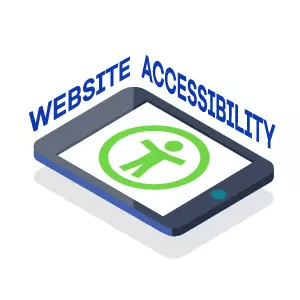To a lot of people The American Disabilities Act Website Compliance seems complicated. Maybe your initial thought when you read the title of this article might have been “Do I even need to follow this?” In short, yes. Every website needs to follow Americans With Disabilities Act (ADA).
In this article we dive into detail about what is ADA and why follow it to begin with. We also discuss WCAG 2.0 Level AA and some guidelines to follow.
What Is The American Disabilities Act?
The American Disabilities Act was developed in 1990. It’s a way to ensure that websites follow specific guidelines that allow people with disabilities to have the same opportunities as everyone else. ADA compliance applies to websites and mobile apps. Your website needs to be accessible to anyone with a vision, physical or hearing disabilities.
Web Content Accessibility Guidelines (WCAG) 2.0 Level AA covers how you can make your website accessible (discussed in detail below).
Why Follow Website Compliance?
Firstly, why should you bother? It’s probably not a big deal, right?
Nope. In fact quite the opposite. In short, someone will sue you if you get caught. Now some websites are highly unlikely to receive a ADA Website Compliance lawsuit or demand letter. For example say you’re writing a blog about your family and you only share with your grandparents. Because it’s only for one small group of people, two in fact, no ones going to bat an eye. In other words you’re likely not going to grab any attention from a plaintiff’s law firm. However it is important remember that even though your website will likely be ignored, you still have to follow ADA.
Another reason to follow ADA Website Compliance is because it improves your SEO. How? It’s pretty simple. For instance, you can do this by implementing things like meta tagging, video transcripts and ALT texts. It also increases your target audience because nearly 50 million people in the U.S have disabilities.
What Is WCAG 2.0 Level AA?
WCAG 2.0 Level AA are guidelines that you can follow to make your website accessible. The WCAG 2.0 AA success criteria is a list of 38 requirements (including level A).
WCAG 2.0 AA has four categories.
1. Perceivable
This category covers ALT texts and alternatives for time based media. You have to make sure your content is shown in different ways thus making it easier for users to see and hear content. You have to separate foreground from background to make this possible.
2. Operable
The focus here is navigation such as functionality available from the keyboard. This means you’ll have to make your website can be used via strictly keyboard if need be. You also have to make sure to not design content in a way that may cause seizures. You can avoid this by not using videos that are always flashing anytime you open the page.
3. Understandable
The purpose of this category is make things intuitive. You have to make things easy to understand. Easy to use websites make for better experiences. Your content has to be readable, and you have to design it in a way that helps users avoid mistakes. You have make sure the webpages appear and operate in predictable ways.
4. Robust
You have to use assistive technology to maximize compatibility with user agents (current and future).
By following these guidelines your content will be accessible to a wider audience. Your website doesn’t need to follow all 38 requirements. But if you follow as many as you can your website in good shape. Talk to us about making your website ADA compliant today.




